CHEVROLET TAHOE 1996 1.G Manual Online
Manufacturer: CHEVROLET, Model Year: 1996, Model line: TAHOE, Model: CHEVROLET TAHOE 1996 1.GPages: 403, PDF Size: 20.63 MB
Page 81 of 403
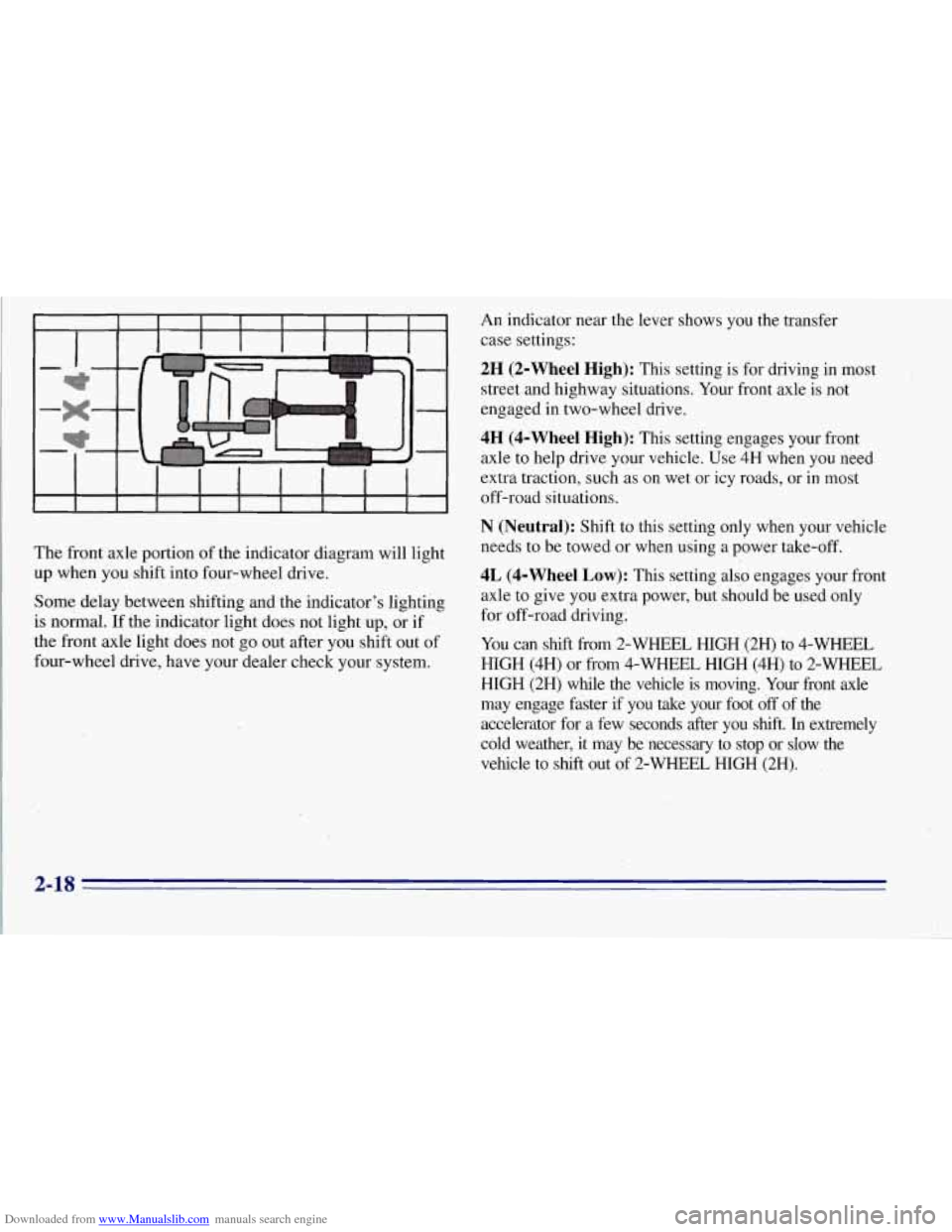
Downloaded from www.Manualslib.com manuals search engine The front axle portion of the indicator diagram will light
up when you shift into four-wheel drive.
Some delay between shifting and the indicator's lighting
is normal. If the indicator light does not light up, or if
the front axle light does not go out after you shift out of
four-wheel drive, have your dealer check your system.
An indicator near the lever shows you the transfer
case settings:
2H (2-Wheel High): This setting is for driving in most
street and highway situations. Your front axle is not
engaged in two-wheel drive.
4H (4-Wheel High): This setting engages your front
axle
to help drive your vehicle. Use 4H when you need
extra traction, such as on wet
or icy roads, or in most
off-road situations.
N '(Neutral): Shift to this setting only when your vehicle
needs to be towed or when using a power take-off.
4L (4-Wheel Low): This setting also engages your front
axle to give you extra power, but should be used- only
for off-road driving.
You can shift from 2-WHEEL HIGH (2H) to 4-WHEEL
HIGH (4H) or from 4-WHEEL HIGH (4H) to 2-WHEEL
HIGH
(2H) while the vehicle is moving. Your front axle
may engage faster if you take
your foot off of the
accelerator for a few seconds after you shift.
In extremely
cold weather, it may be necessary to stop or slow the
vehicle to
shift out of 2-WHEEL HIGH (2H). .
,
2-18
Page 82 of 403
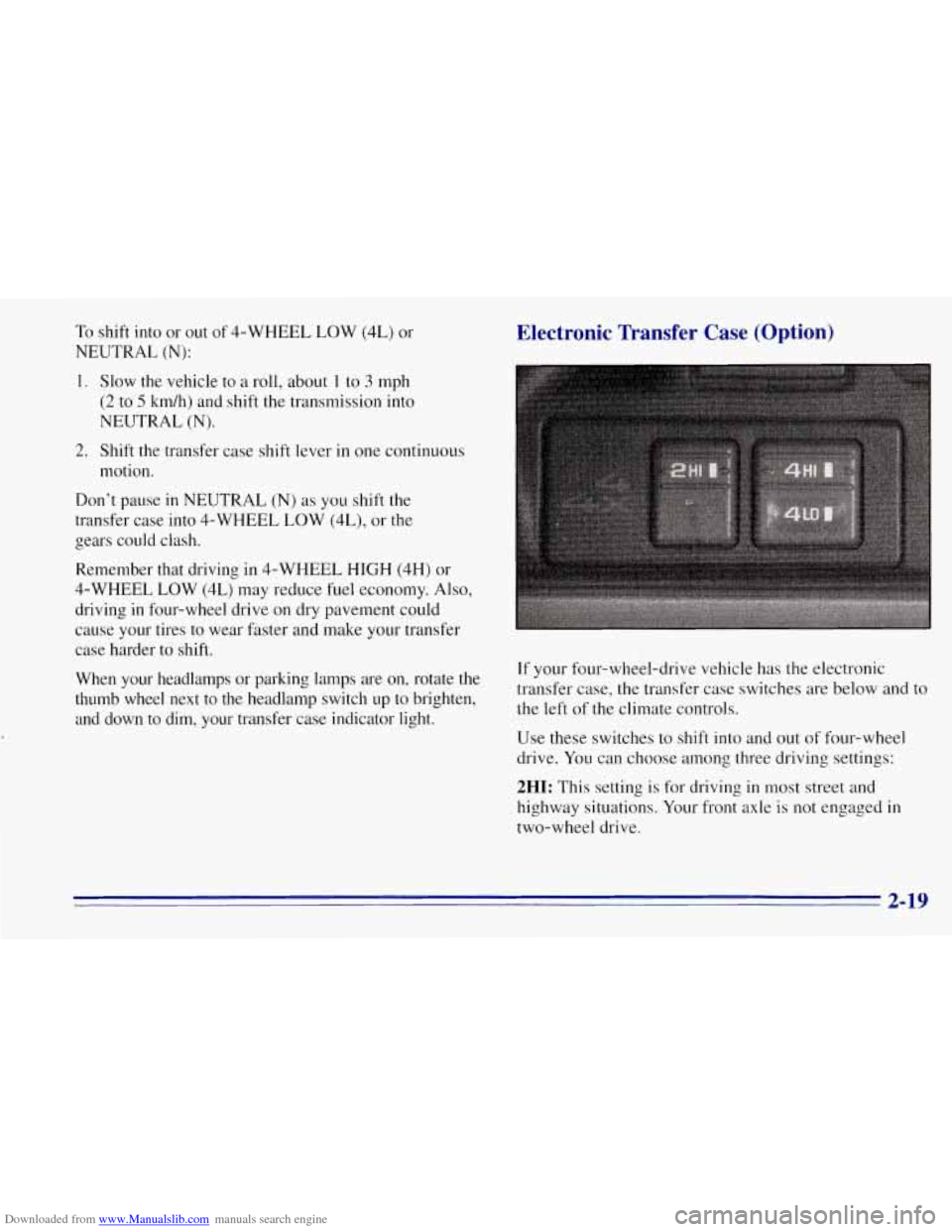
Downloaded from www.Manualslib.com manuals search engine To shift into or out of 4-WHEEL LOW (4L) or
NEUTRAL (N):
1. Slow the vehicle to a roll, about 1 to 3 mph
(2 to 5 km/h) and shift the transmission into
NEUTRAL (N).
2. Shift the transfer case shift lever in one continuous
motion.
Don’t pause
in NEUTRAL (N) as you shift the
transfer case into 4-WHEEL LOW (4L), or the
gears could clash.
Remember that driving
in 4-WHEEL HIGH (4H) or
4-WHEEL LOW (4L) may reduce fuel economy. Also,
driving
in four-wheel drive on dry pavement could
cause your tires
to wear faster and make your transfer
case harder to shift.
When your headlamps or parking lamps are on, rotate the
thumb wheel next to the headlamp switch up to brighten,
and down to dim, your transfer case indicator light.
Electronic Transfer Case (Option)
If your four-wheel-drive vehicle has the electronic
transfer case, the transfer case switches are below and to
the left of the climate controls.
Use these switches to shift into and out of four-wheel
drive.
You can choose among three driving settings:
2HI: This setting is for driving in most street and
highway situations. Your front axle is not engaged
in
two-wheel drive.
2-19
Page 83 of 403
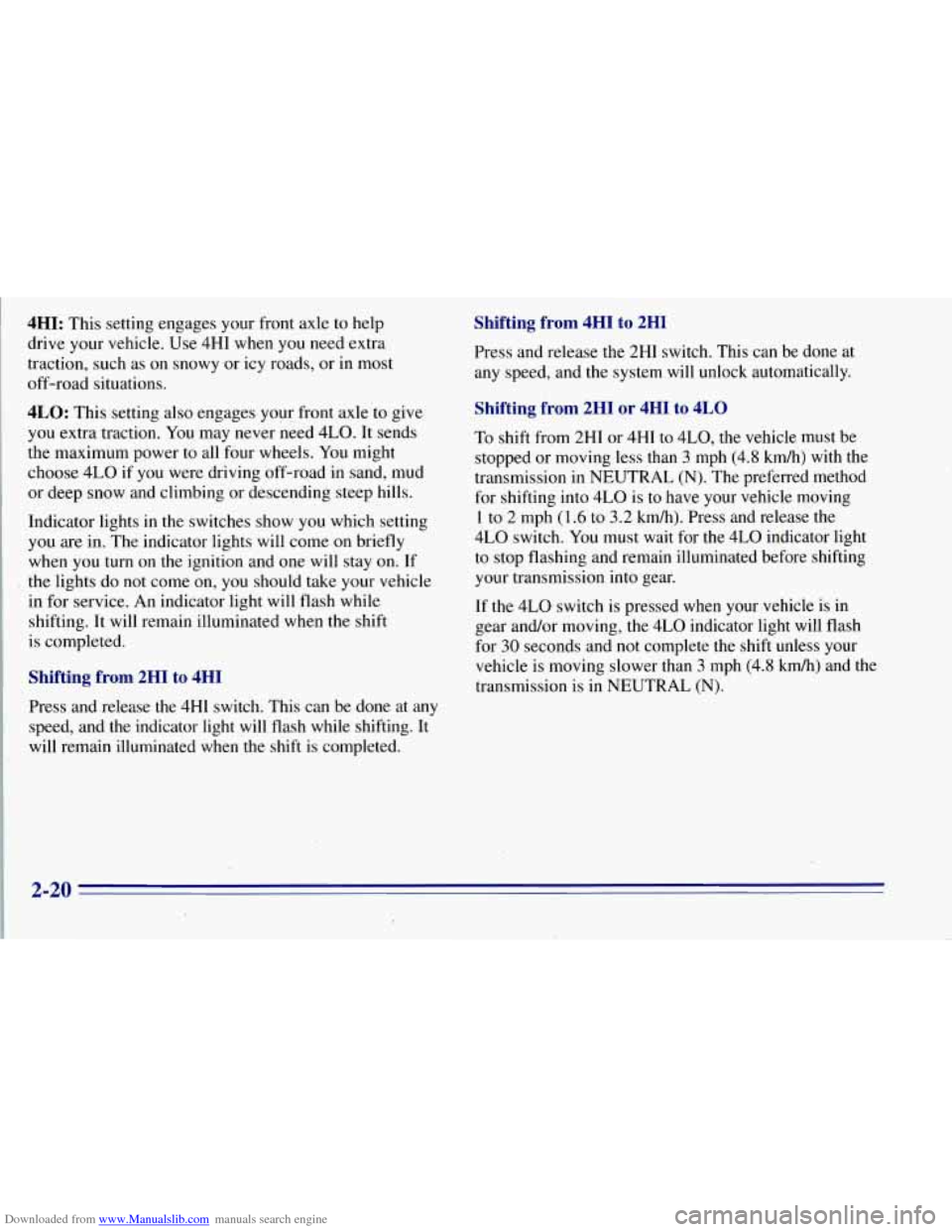
Downloaded from www.Manualslib.com manuals search engine 4HI: This setting engages your front axle to help
drive your vehicle. Use 4HI when
you need extra
traction, such as on snowy or icy roads, or in most
off-road situations.
4LO: This setting also engages your front axle'to give
you extra traction.
You may never need 4LO. It sends
the maximum power to all four wheels. You might
choose 4LO if
you were driving off-road in sand, mud
or deep snow and climbing or descending steep hills.
Indicator lights in the switches show
you which setting
you are in. The indicatorlights will come on briefly
when ,you turn on the ignition and one will stay on. If
the lights do not come on, you should take your vehicle
in for service. An indicator light will flash while
shifting. It will remain illuminated when the shift
is completed.
Shifting from 2HI to 4HI
,Press and release the 4HI switch. This can be done at any
speed,
and the indicator light will flash while shifting. It
will remain illuminated when the shift is completed.
Shifting from 4HI to 2HI
Press and release the 2HI switch. This can be done at
any speed, and the system will unlock automatically.
Shifting from 2HI or 4HI to 4LO
To shift from 2HI or 4HI to 4L0, the vehicle must be
stopped or moving less than
3 mph (4.8 km/h) with the
transmission in NEUTRAL (N). The preferred method
for shifting into 4LO is to have your vehicle moving
1 to 2 mph (1.6 to 3.2 km/h). Press and release the
4LO switch. You must wait for the 4LO indicator light
to stop flashing and remain illuminated before shifting
your transmission into gear.
If the 4LO switch is pressed when your vehicle is in
gear and/or moving, the 4LO indicator light will flash
for
30 seconds and not complete the shift unless your
vehicle is moving slower than
3 mph (4.8 km/h) and the
transmission is in NEUTRAL (N).
I 2-20
Page 84 of 403
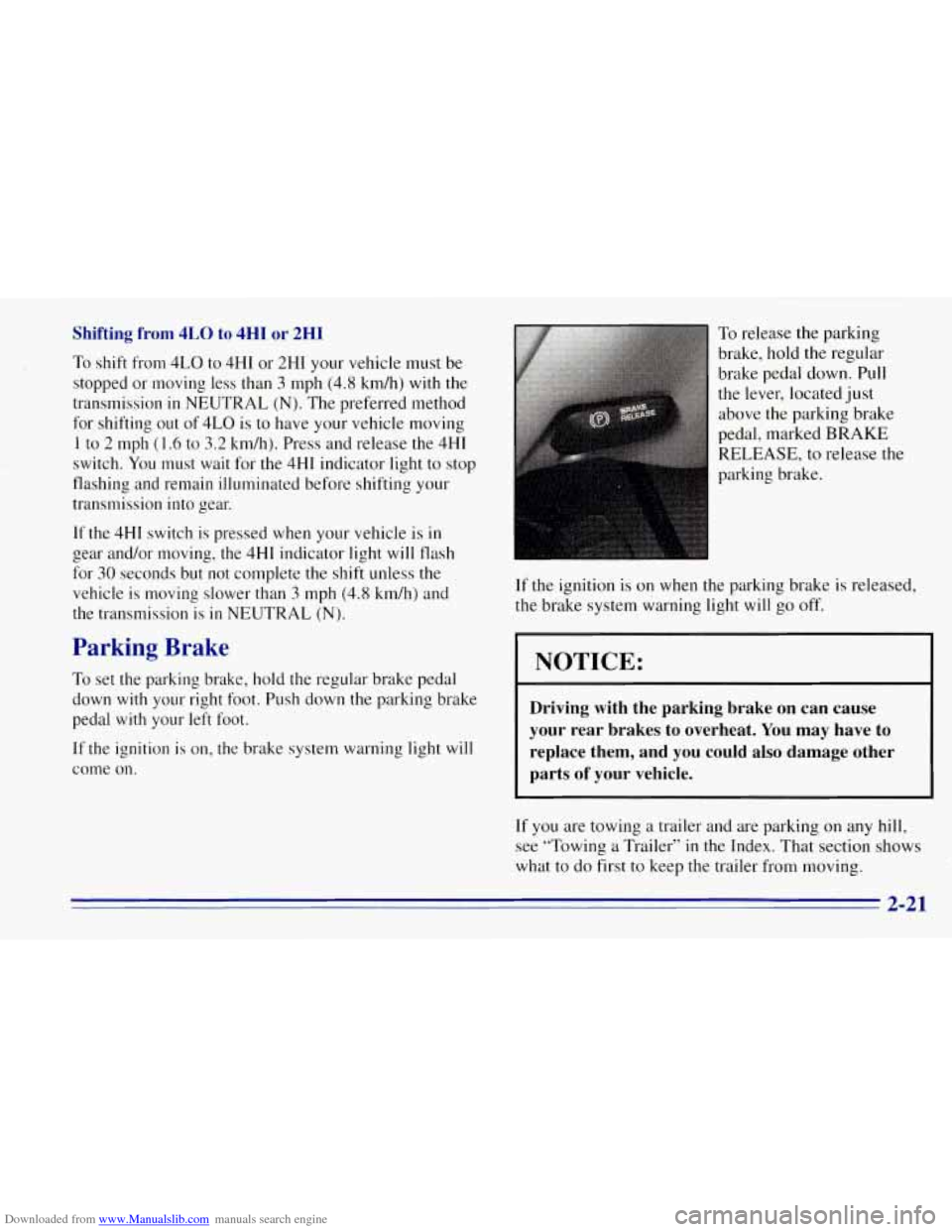
Downloaded from www.Manualslib.com manuals search engine Shifting from 4LO to 4HI or 2HI
To shift from 4LO to 4HI or 2HI your vehicle must be
stopped or moving less than
3 mph (4.8 kdh) with the
transmission
in NEUTRAL (N). The preferred method
for shifting out of 4LO is to have your vehicle moving
1 to 2 mph (1.6 to 3.2 kdh). Press and release the 4HI
switch.
You must wait for the 4HI indicator light to stop
flashing and remain illuminated before shifting your
transmission into gear.
If the 4HI switch is pressed when your vehicle is in
gear and/or moving, the 4HI indicator light
will flash
for
30 seconds but not complete the shift unless the
vehicle is moving slower than
3 mph (4.8 kdh) and
the transmission is
in NEUTRAL (N).
Parking Brake
To set the parking brake, hold the regular brake pedal
down
with your right foot. Push down the parking brake
pedal with your left foot.
If the ignition
is on, the brake system warning light will
come on.
To release the parking
brake, hold the regular
brake pedal down. Pull
the lever, located just
above the parking brake
pedal, marked
BRAKE
RELEASE, to release the
parking brake.
If the ignition is on when the parking brake is released,
the brake system warning light will
go off.
NOTICE:
Driving with the parking brake on can cause
your rear brakes to overheat. You may have to
replace them, and you could also damage other
parts
of your vehicle.
If you are towing a trailer and are parking on any hill,
see “Towing a Trailer” in the Index. That section
shows
what to do first to keep the trailer from moving.
2-21
Page 85 of 403
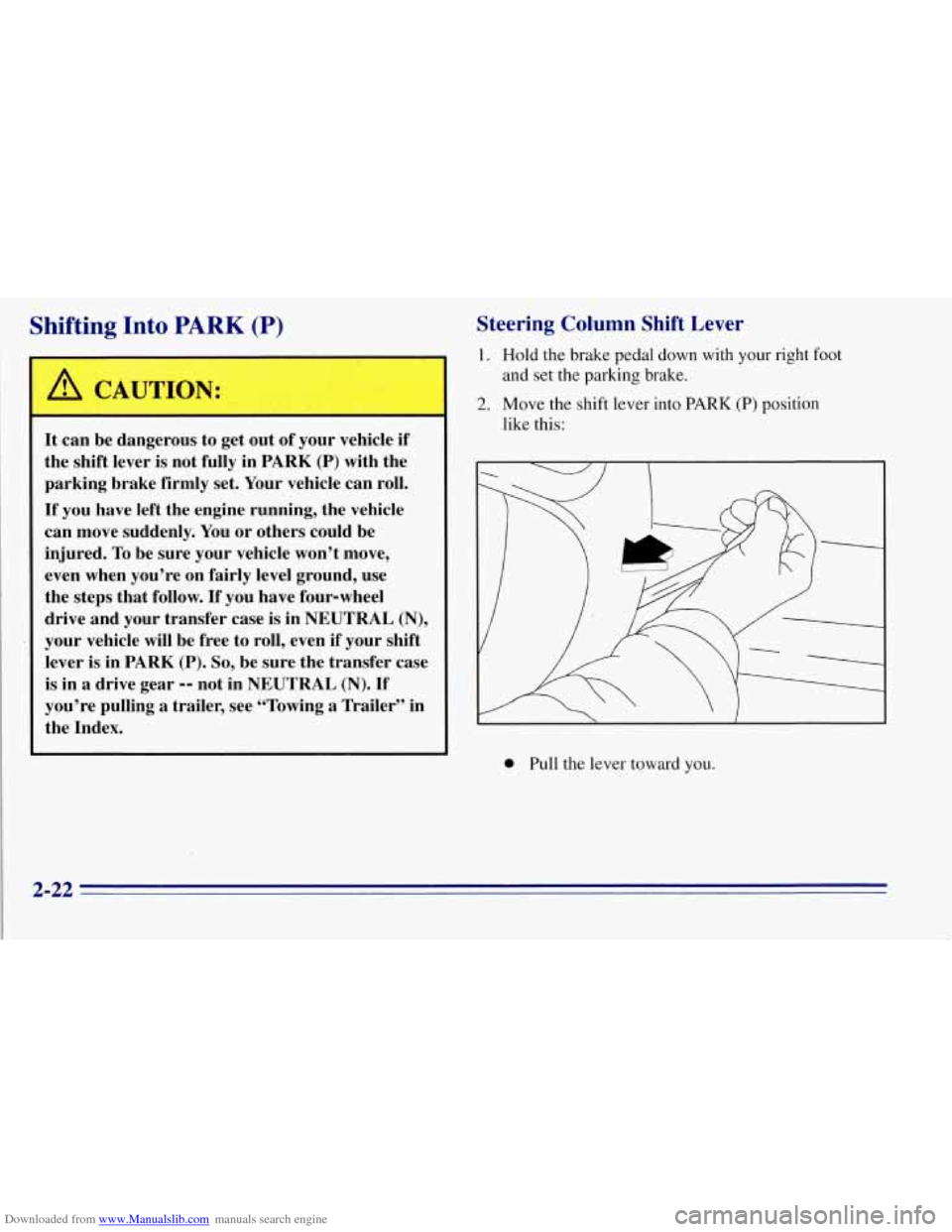
Downloaded from www.Manualslib.com manuals search engine Shifting Into PARK (P)
A CAUTION:
It can be dangerous to get out of your vehicle if
the shift lever is not fully in PARK
(P) with the
parking brake firmly set. Your vehicle can roll.
If you have left the engine running, the vehicle
can move suddenly. You or others could be
injured.
To be sure your vehicle won’t move,
even when you’re on fairly level ground, use
the steps that follow.
If you have four-wheel
drive and your transfer case is in NEUTRAL (N),
your vehicle will be free to roll, even if your shift
lever is in PARK (P).
So, be sure the transfer case
is in
a drive gear -- not in NEUTRAL (N). If
you’re pulling a trailer, see “Towing
a Trailer” in
the Index.
Steering Column Shift Lever
1. Hold the brake pedal down with your right foot
2. Move the shift lever into PARK (P) position
and set the
parking brake.
like this:
0 Pull the lever toward you.
2-22
Page 86 of 403
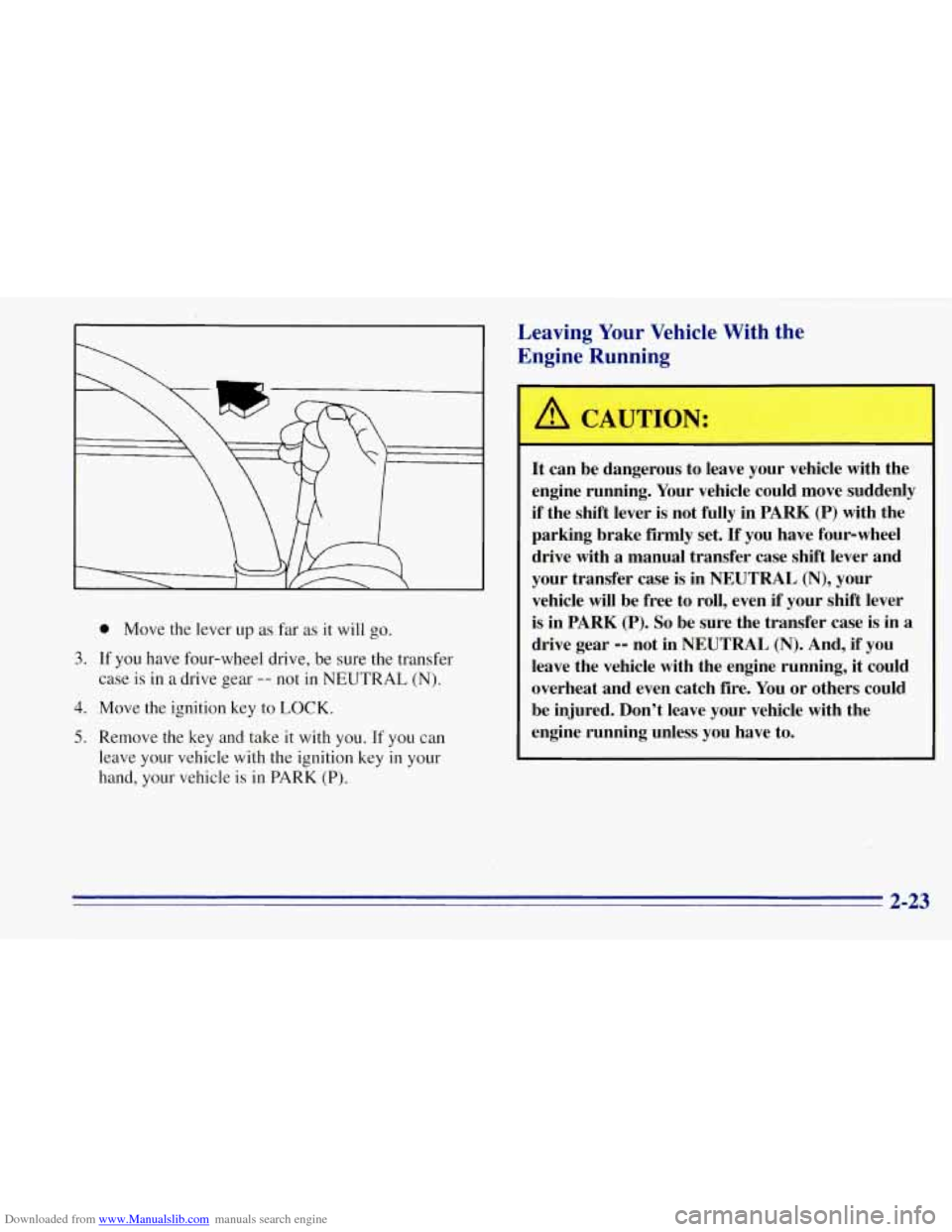
Downloaded from www.Manualslib.com manuals search engine 0 Move the lever up as far as it will go.
3. If you have four-wheel drive, be sure the transfer
case is in a drive gear
-- not in NEUTRAL (N).
4. Move the ignition key to LOCK.
5. Remove the key and take it with you. If you can
leave your vehicle with the ignition key
in your
hand, your vehicle is in PARK (P).
Leaving Your Vehicle With the
Engine Running
A LAUTION:
It can be dangerous to leave your vehicle with the
engine running.
Your vehicle could move suddenly
if the shift lever is not fully in PARK
(P) with the
parking brake
firmly set. If you have four-wheel
drive with
a manual transfer case shift lever and
your transfer case is in
NEUTRAL (N), your
vehicle will be free to roll, even
if your shift lever
is in PARK (P).
So be sure the transfer case is in a
drive gear -- not in NEUTRAL (N). And, if you
leave the vehicle with the engine running, it could
overheat and even catch fire.
You or others could
be injured. Don’t leave your vehicle with the
engine running unless you have to.
2-23
Page 87 of 403
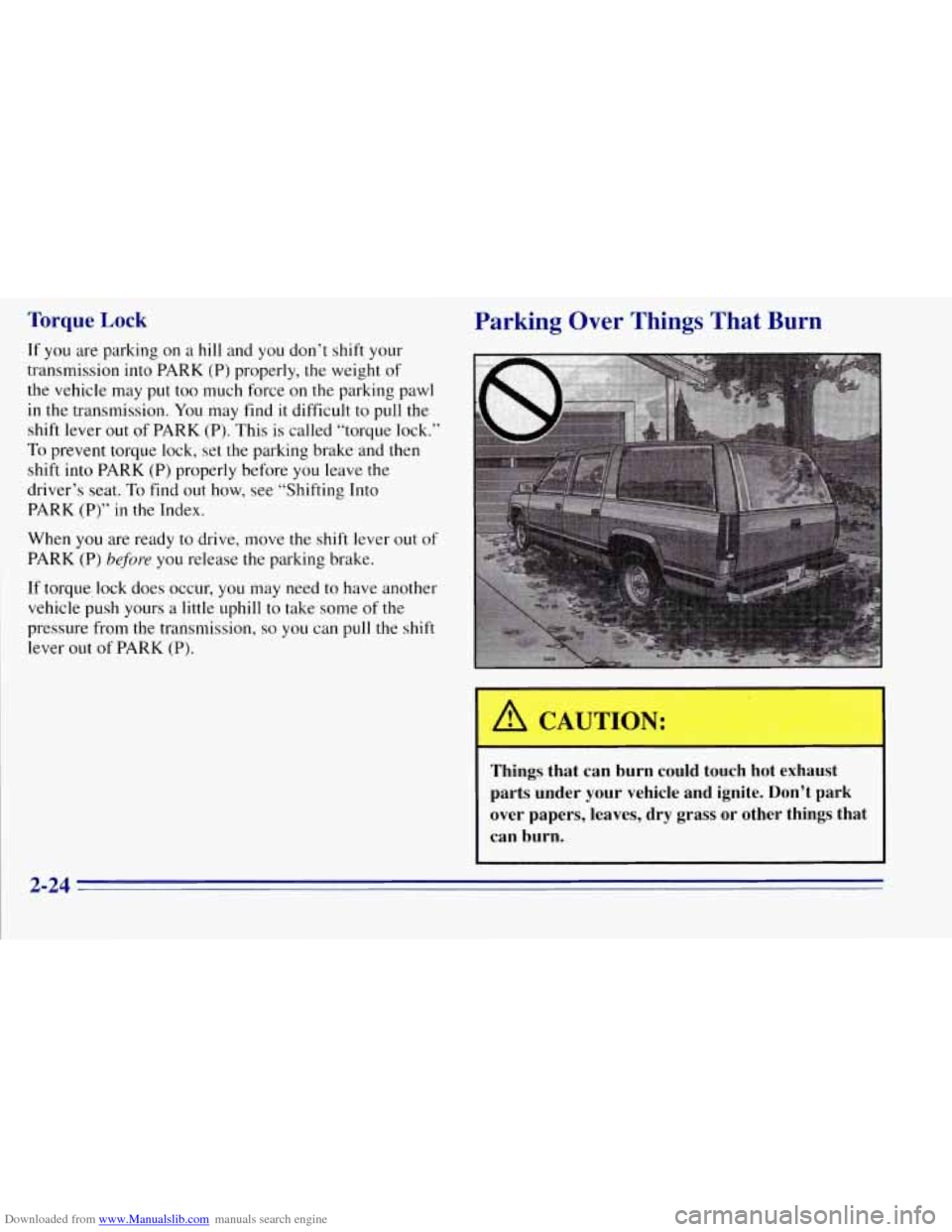
Downloaded from www.Manualslib.com manuals search engine Torque Lock
If you are parking on a hill and you don’t shift your
transmission into PARK (P) properly, the weight
of
the vehicle may put too much force on the parking pawl
in the transmission. You may find it difficult to pull the
shift lever out
of PARK (P). This is called “torque lock.”
To prevent torque lock, set the parking brakeland then
shift into PARK
(P) properly before you leave the
driver’s seat.
To find out how, see “Shifting Into
PARK (P)” in
the Index.
When
you are ready to drive, move the shift lever out of
PARK (P) before you release the parking brake.
If torque,
lock does occur, you may need to have another
vehicle push yours a little uphill to take some of the
pressure from the transmission,
so you can pull the shift
lever
out of PARK (P).
Parking Over Things That Burn
Things that can burn could touch hot exhaust
parts under your vehicle and ignite. Don’t park
over papers, leaves, dry grass or other things that
can burn.
I I
2-24
Page 88 of 403
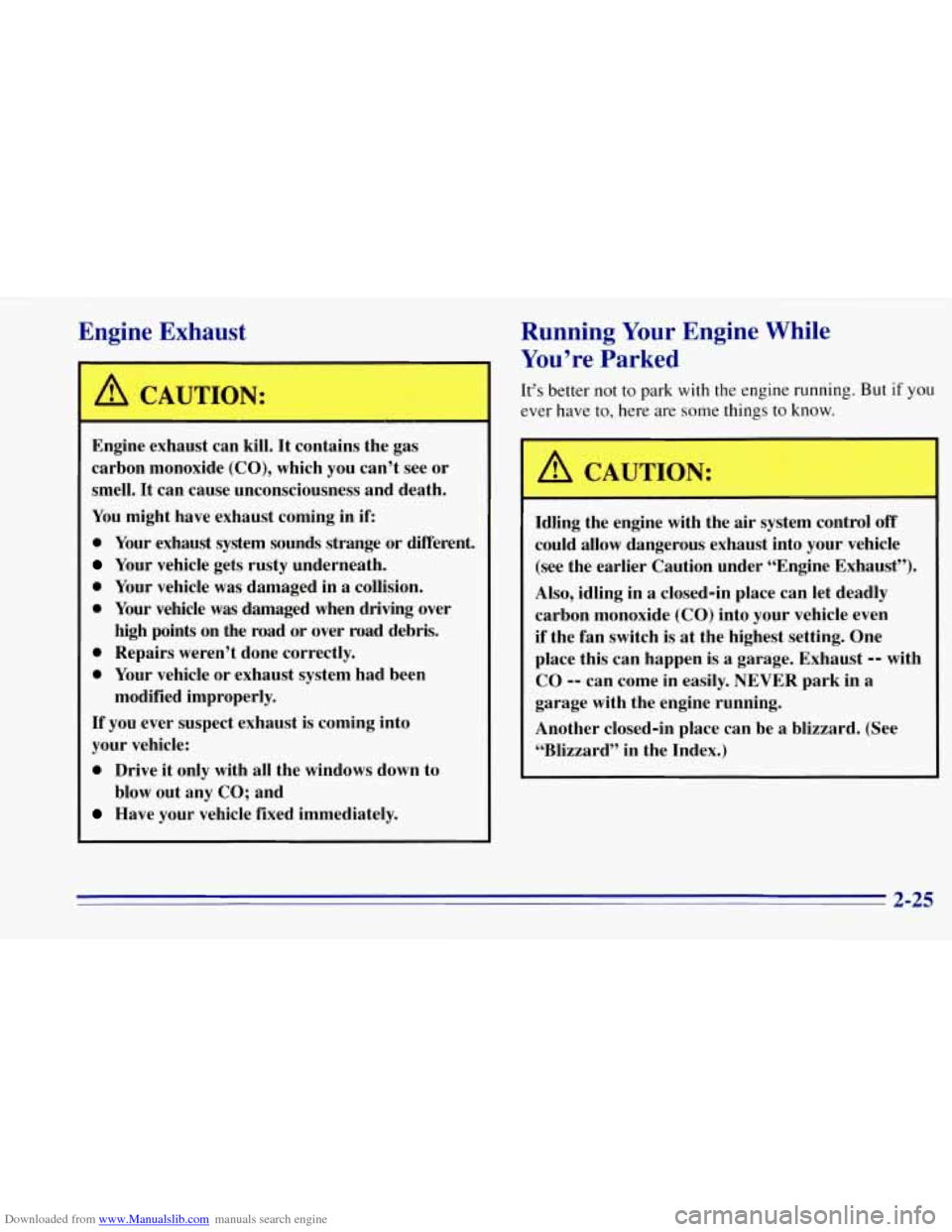
Downloaded from www.Manualslib.com manuals search engine Engine Exhaust
A CAUTION:
Engine exhaust can kill. It contains the gas
carbon monoxide
(CO), which you can’t see or
smell. It can cause unconsciousness and death.
You might have exhaust coming in if:
0 Your exhaust system sounds strange or different.
Your vehicle gets rusty underneath.
0 Your vehicle was damaged in a collision.
0 Your vehicle was damaged when driving over
high points on the road or over road debris.
0 Repairs weren’t done correctly.
0 Your vehicle or exhaust system had been
If you ever suspect exhaust is coming into
your vehicle:
0 Drive it only with all the windows down to
Have your vehicle fixed immediately.
modified improperly.
blow
out any
CO; and
Running Your Engine While
You’re Parked
It‘s better not to park with the engine running. But if you
ever have to, here are some things to know.
A CAUTION:
Idling the engine with the air system control off
could allow dangerous exhaust into your vehicle
(see the earlier Caution under “Engine Exhaust”).
Also, idling in
a closed-in place can let deadly
carbon monoxide
(CO) into your vehicle even
if the fan switch is at the highest setting. One
place this can happen is a garage. Exhaust
-- with
CO -- can come in easily. NEVER park in a
garage with the engine running.
Another closed-in place can be
a blizzard. (See
“Blizzard” in the Index.)
2-25
Page 89 of 403
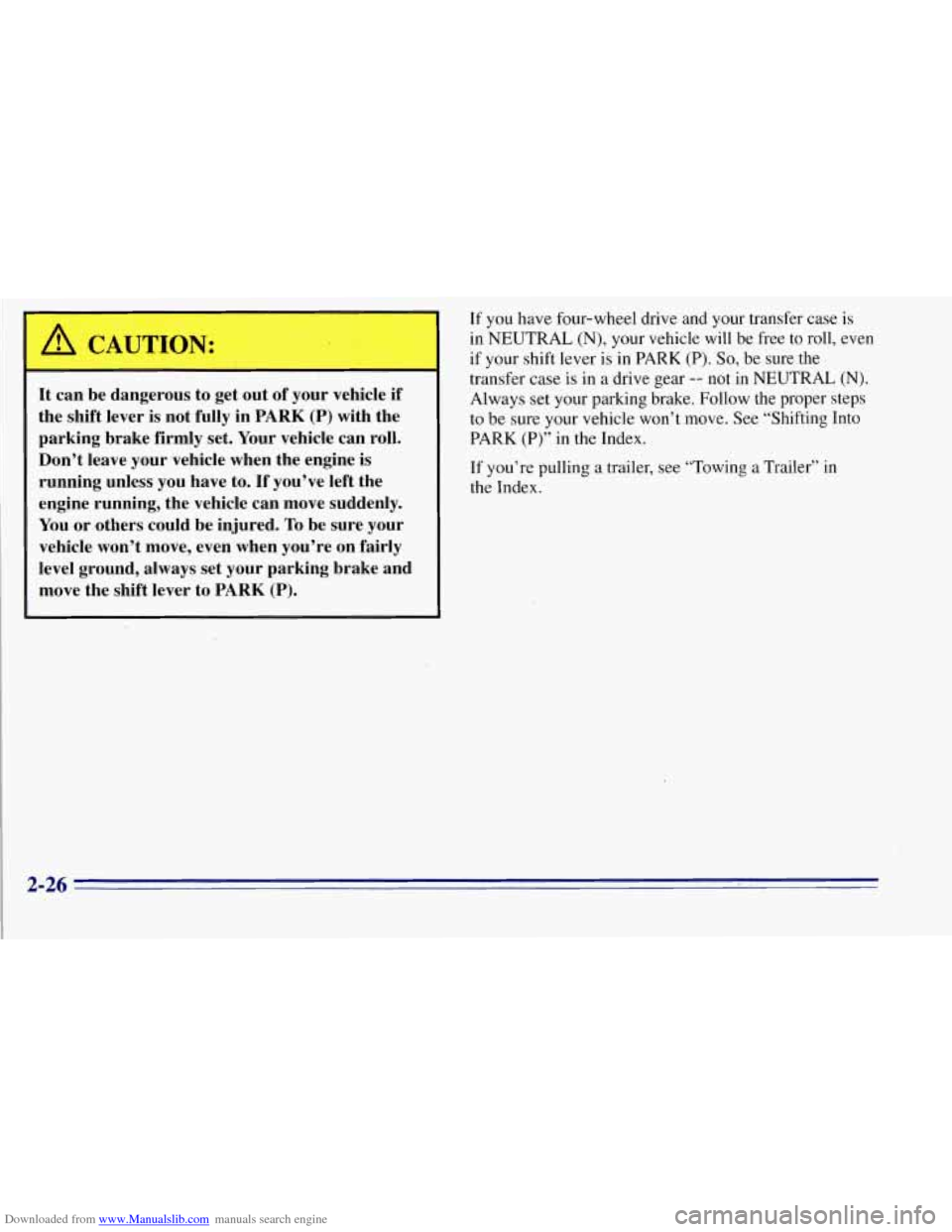
Downloaded from www.Manualslib.com manuals search engine A CAUTION:
A
It can be dangerous to get out of your vehicle if
the shift lever is not fully in
PARK (P) with the
parking brake firmly set. Your vehicle can roll.
Don’t leave your vehicle when the engine
is
running unless you have to. If you’ve left the
engine running, the vehicle can move suddenly.
You or others could be injured.
To be sure your
vehicle won’t move, even when you’re on fairly
level ground, always set your parking brake and
move the shift lever to
PARK (P).
If you have four-wheel drive and your transfer case is
in NEUTRAL (N), your vehicle will be free to roll, even
if your shift lever is in PARK
(P). So, be sure the
transfer case is in a drive gear
-- not in NEUTRAL (N).
Always set your parking brake. Follow the proper steps
to be sure your vehicle won’t move. See “Shifting Into
PARK (P)” in the Index.
If you’re pulling a trailer, see “Towing a Trailer” in
the Index.
1
2-26
Page 90 of 403
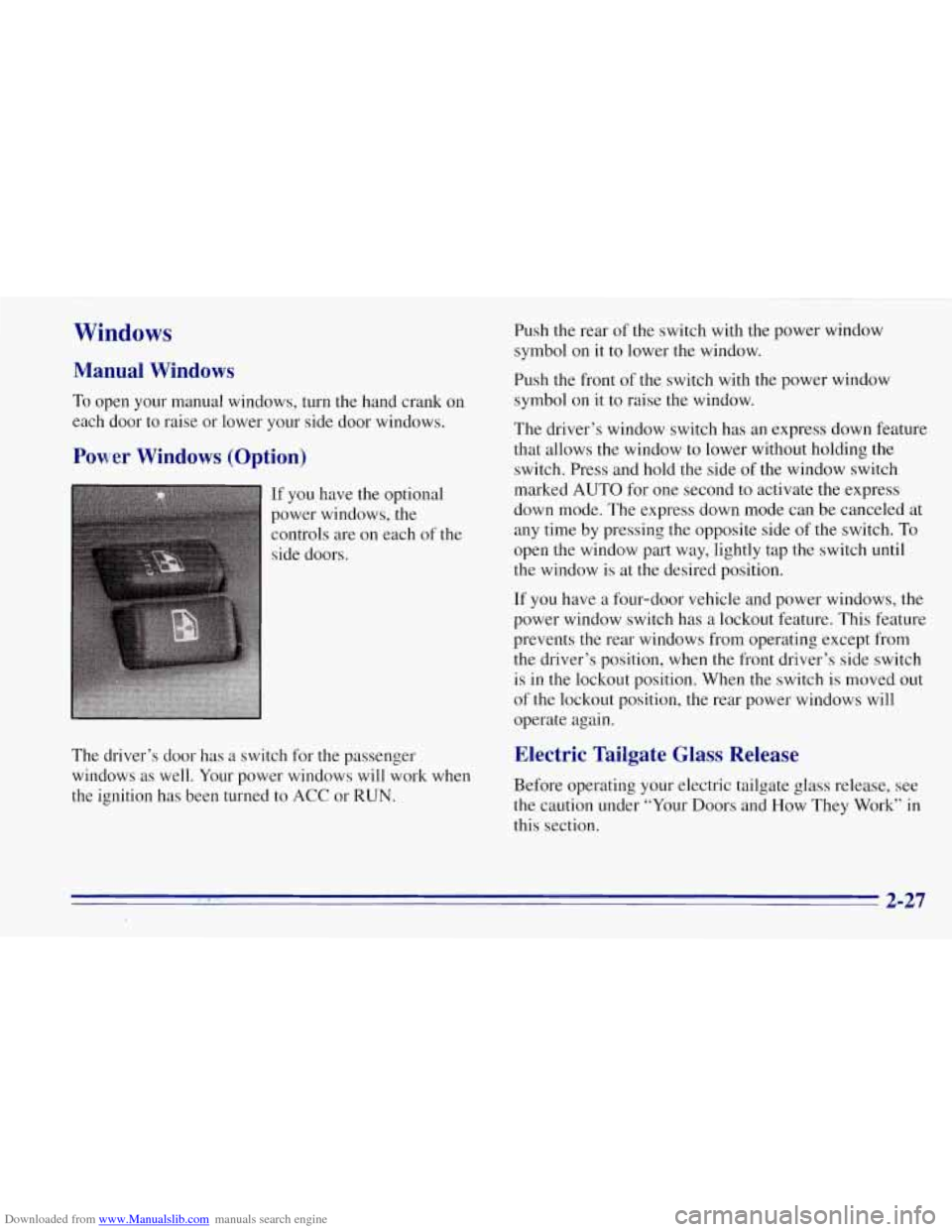
Downloaded from www.Manualslib.com manuals search engine Windows
Manual Windows
To open your manual windows, turn the hand crank on
each door to raise or lower your side door windows.
Power Windows (Option)
If you have the optional
power windows, the controls are on each of the
side doors.
The driver’s door has a switch for the passenger
windows as well. Your power windows will work when
the ignition has been turned to
ACC or RUN.
Push the rear of the switch with the power window
symbol on it to lower the window.
Push the front of the switch with the power window
symbol on
it to raise the window.
The driver’s window switch has an express down feature
that allows the window to lower without holding the
switch. Press and hold the side
of the window switch
marked
AUTO for one second to activate the express
down mode. The express down mode can be canceled at
any time by pressing the opposite side
of the switch. To
open the window part way, lightly tap the switch until
the window is at the desired position.
If you have a four-door vehicle and power windows, the
power window switch has a lockout feature. This feature
prevents the rear windows from operating except from
the driver’s position, when the front driver’s side switch
is in the lockout position. When the switch is moved out
of the lockout position, the rear power windows will
operate again.
Electric Tailgate Glass Release
Before operating your electric tailgate glass release, see
the caution under “Your Doors and How They Work’’ in
this section.
2-27